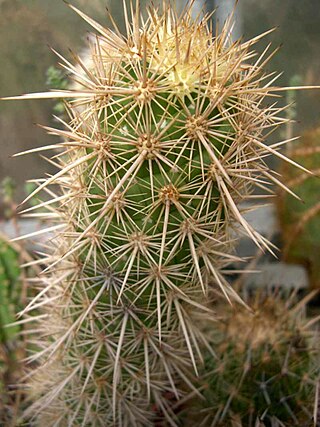Cochemiea angelensis is a species of plant in the family Cactaceae.

Cochemiea tetrancistra is a species of fishhook cactus known by the common name common fishhook cactus. It is native to the Mojave and Sonoran Deserts of northern Mexico and the southwestern United States, where it grows in a variety of desert habitat types.

Cochemiea multidigitata is a species of flowering plant in the family Cactaceae that is endemic to San Pedro Nolasco Island in Mexico, growing on steep slopes. Cochemiea multidigitata sprouts a white to cream-colored flower from spring to early summer.

Cochemiea barbata is a small cactus native to Chihuahua, Sonora, and Durango, with the common name greenflower nipple cactus.

Cochemiea conoidea, common name Texas cone cactus or Chihuahuan beehive, is a species of cactus native to southern United States to central Mexico.

Cochemiea boolii is a species of cactus in the subfamily Cactoideae with pink-petaled flowers.

Cochemiea mainiae is a species of cactus in the subfamily Cactoideae, with the common name counterclockwise nipple cactus.

Cochemiea wrightii is a species of Cochemiea found in Mexico and the southern United States.

Cochemiea blossfeldiana is a species of Cochemiea found in Mexico.

Cochemiea poselgeri is a species of Cochemiea found in Mexico

Cochemiea saboae is a species of Cochemiea found in Mexico.

Cochemiea insularis is a species of Cochemiea found in Mexico.

Cochemiea capensis is a species of Cochemiea found in Mexico.

Cochemiea schumannii is a species of Cochemiea found in Mexico.

Cochemiea theresae is a species of cactus in the subfamily Cactoideae.

Cochemiea armillata is a species of Cochemiea found in Mexico.

Cochemiea halei is a species of Cochemiea found in Mexico.
Cochemiea viridiflora, commonly known as the greenflower nipple cactus or the fishhook pincushion, is a species of Cochemiea found in Southern United States.

Cochemiea phitauiana is a species of Cochemiea found in Mexico.

Cochemiea palmeri is a species of Cochemiea found in Mexico.





















